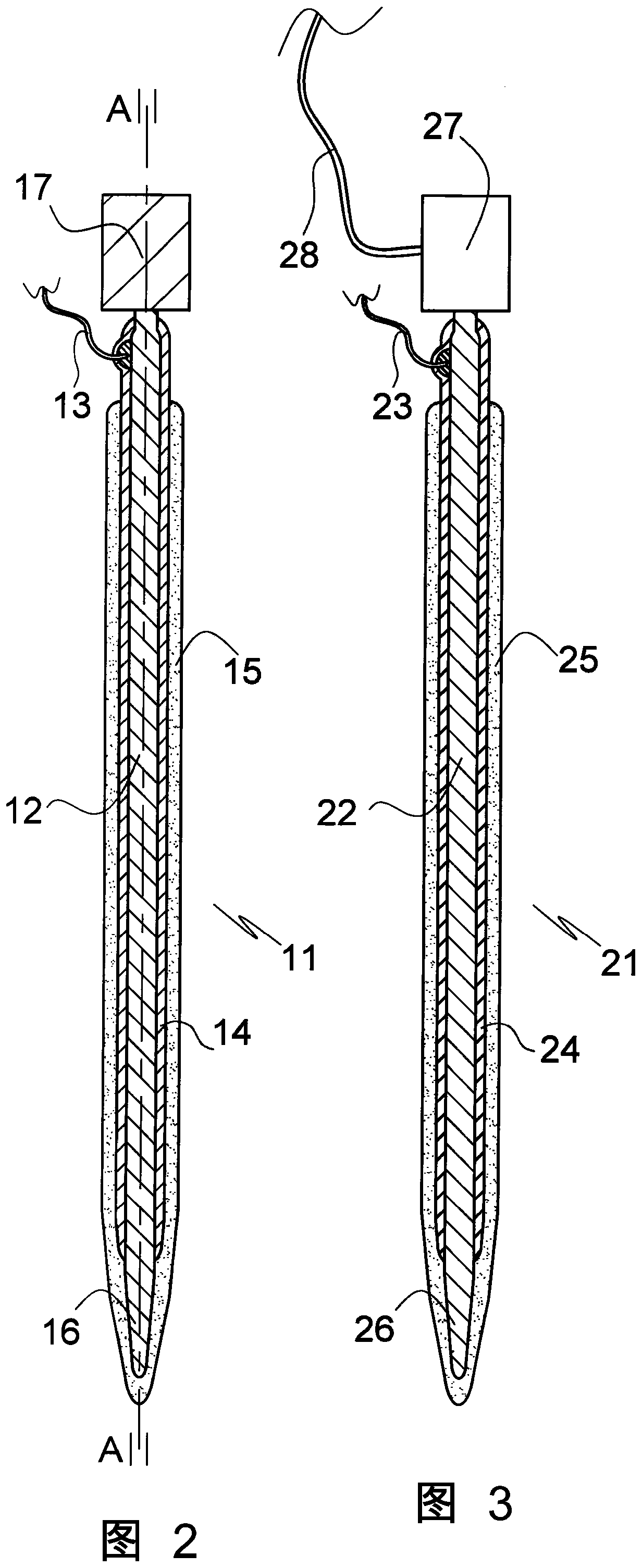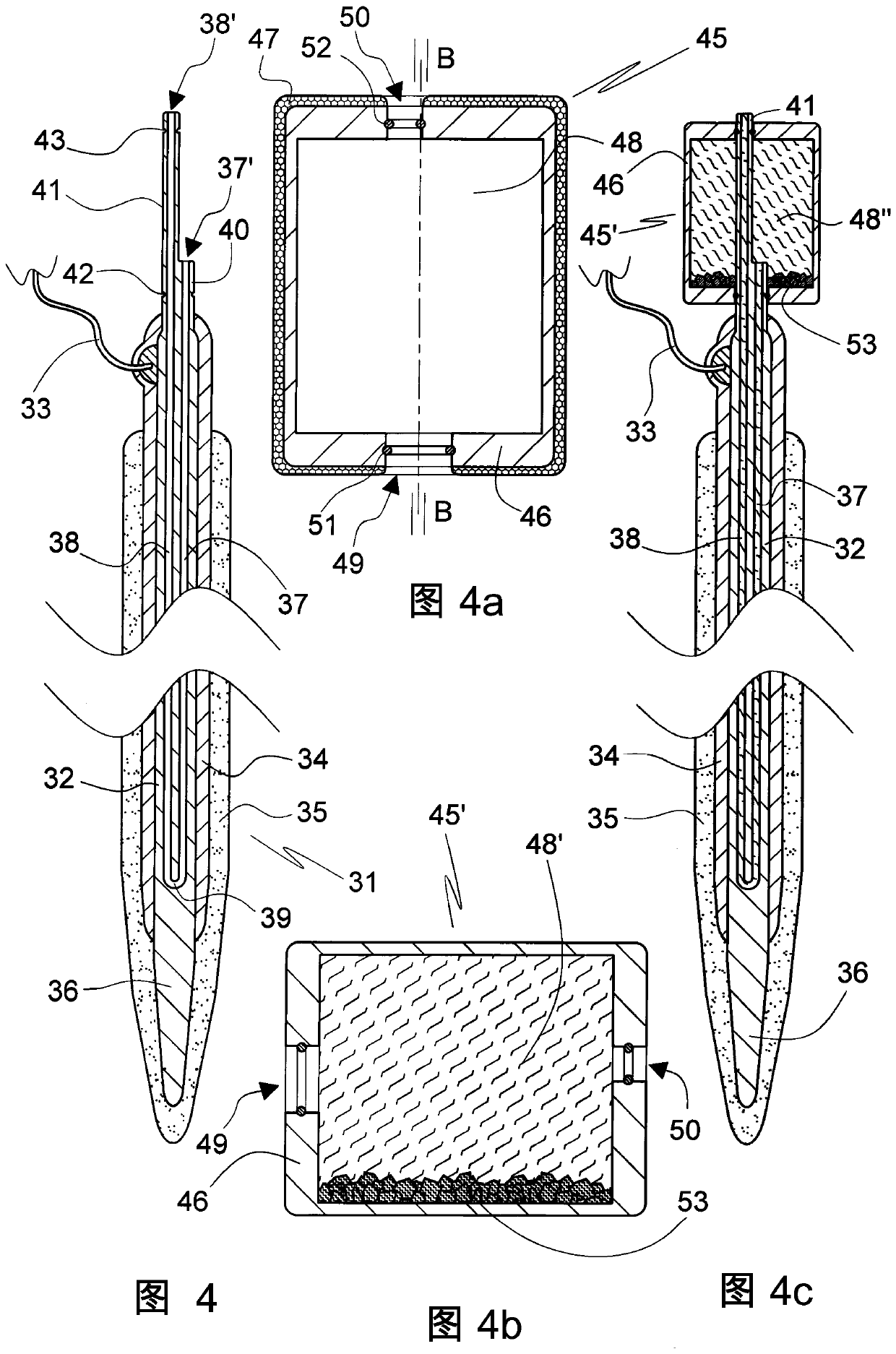Device for insertion into nervous tissue
A device, tissue technology, used in the field of insert components, which can solve problems such as premature dissolution or separation
- Summary
- Abstract
- Description
- Claims
- Application Information
AI Technical Summary
Problems solved by technology
Method used
Image
Examples
example 1
[0096] figure 1 A microelectrode 1 of the art is illustrated comprising an oblong cylindrical metal electrode body 2, such as silver, gold, platinum or iridium, having a narrowed distal tip 6 and attached to it. Flexible electrical leads 3 at the distal end. Apart from the tip 6, the electrode body 2 is electrically insulated by a layer 4 of polymer material, such as polyurethane or parylene C. The electrode body 2 and the tip 6 are covered with a dry gelatin layer 5 of 120 gelatin strength except for a portion extending from the proximal end. The electrode 1 is shown inserted into a test tube shaped cooling container 7 with its distal tip 6 at the front. A container 7, which may be insulated (not shown), is loaded with dry ice 8 provided at its bottom. Electrode 1 is cooled by gaseous carbon dioxide 9 evaporated from dry ice 8 . The temperature of the carbon dioxide 9 gas in the container is monitored by a thermocouple 10 ; alternatively or additionally, the temperature o...
example 2
[0099] figure 2 The design of the microelectrode 11 according to the invention shown in axial section A-A basically corresponds to the design of the microelectrode 1 of Example 1, except that the cooling means in the form of a heat sink 17 is in thermal communication between the electrodes. The proximal end of the body 12 is attached to the electrode body 12 . Before implanting the microelectrode 11, the heat sink 17 is cooled in combination with the electrode 11 or alone to a low temperature, such as the temperature to which the electrode 11 is cooled or even lower or significantly lower. With the heat sink 17 at a lower temperature than the electrode 11, heat flows from the electrode body 12 to the heat sink 17, thereby cooling the electrode 11 and thus delaying the process of covering most of the Swelling and dissolution of the gel-like or other expandable layer 15 on the insulating layer 14 of the electrode body 12 . Suitable heat sink materials include steel, copper, c...
example 3
[0101] image 3 in and figure 2 The design of the microelectrode 21 of the present invention shown in the axial section corresponding to the axial section A-A of the embodiment basically corresponds to the design of the microelectrode 11 of Example 2, except that it has the form of a Peltier element 27 A cooling device (rather than a heat sink) is attached to the electrode body 22 at its proximal end in thermal communication. The Peltier element 27 is powered via an insulated flexible lead 28 . The microelectrode 21 comprises correspondingly arranged insulating and expandable layers 24 , 25 on the electrode body 22 , the narrowed distal end portion 26 of the electrode body 22 being similarly free of the insulating layer 24 . The electrode body 22 is electrically connected to a power source (not shown) and / or an instrument (not shown) for detecting voltage changes by means of electrically insulated flexible leads 23 . Upon completion of the insertion procedure, the cooled t...
PUM
 Login to View More
Login to View More Abstract
Description
Claims
Application Information
 Login to View More
Login to View More - R&D
- Intellectual Property
- Life Sciences
- Materials
- Tech Scout
- Unparalleled Data Quality
- Higher Quality Content
- 60% Fewer Hallucinations
Browse by: Latest US Patents, China's latest patents, Technical Efficacy Thesaurus, Application Domain, Technology Topic, Popular Technical Reports.
© 2025 PatSnap. All rights reserved.Legal|Privacy policy|Modern Slavery Act Transparency Statement|Sitemap|About US| Contact US: help@patsnap.com



